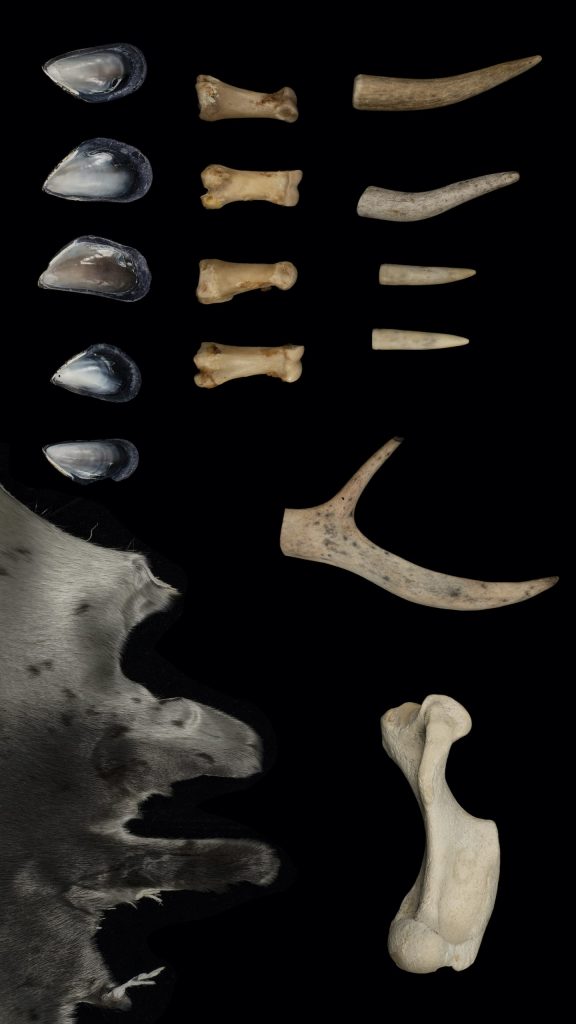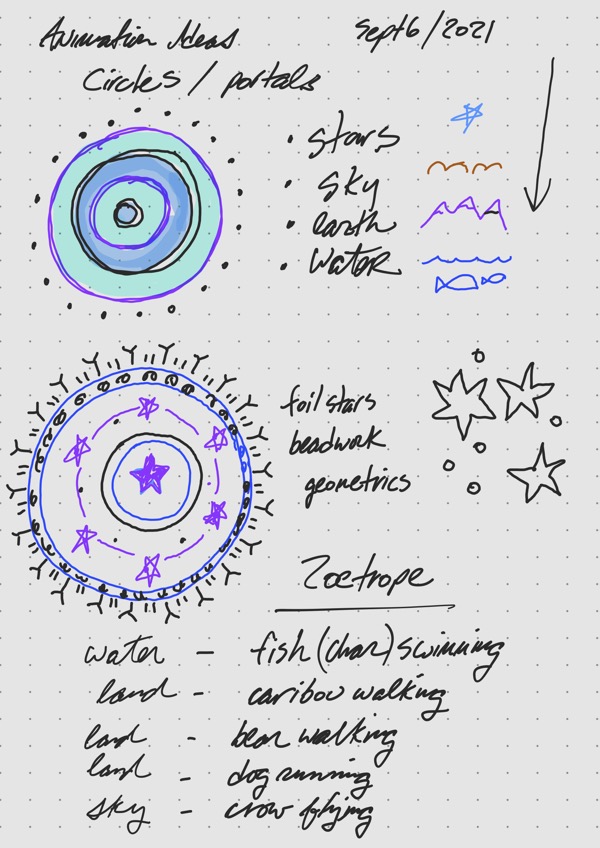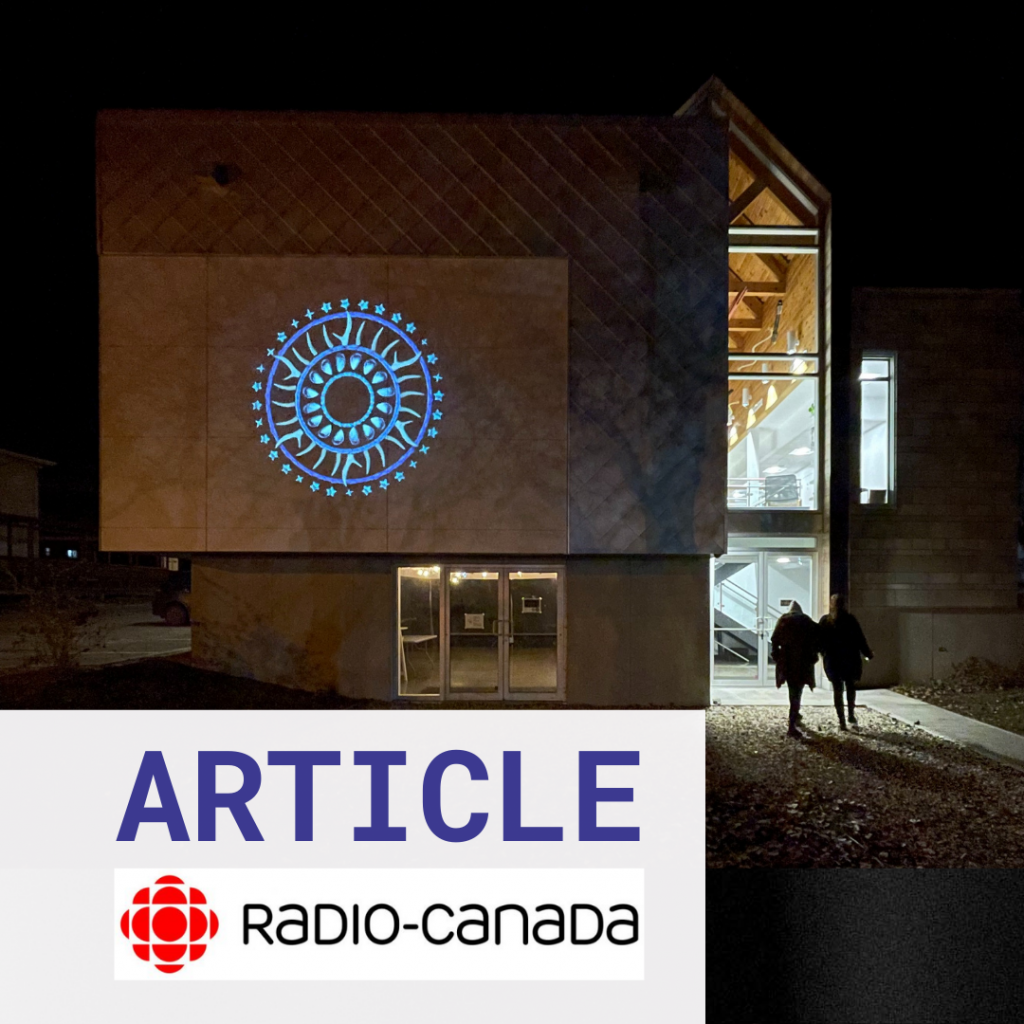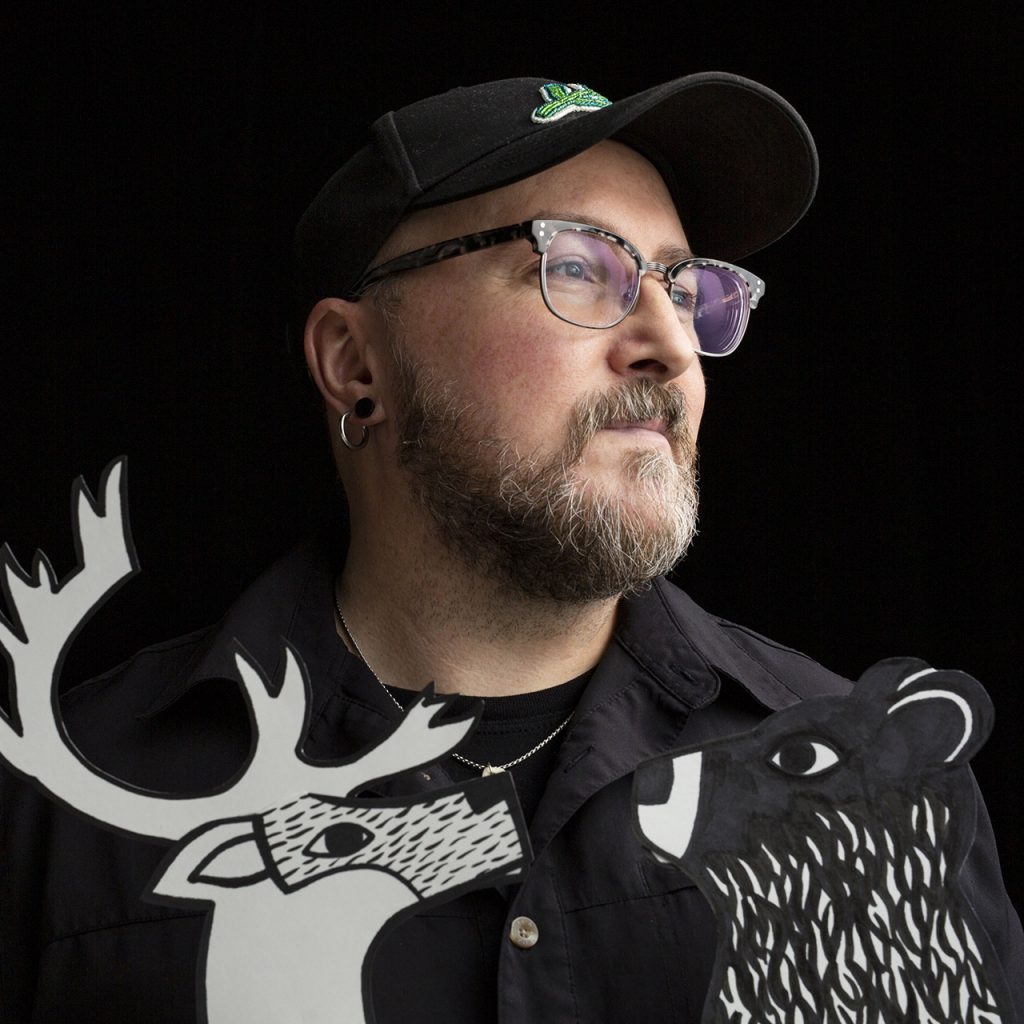Ullugialijak (Starry Night) — Glenn Gear
Inuktitut version follows
The projection
Passers-by at the Parc de L’Imaginaire will be able to enjoy this nocturnal projection on Fridays, Saturdays and Sundays from November 27, 2021, to February 27, 2022, from 6 to 10 p.m.

The work


Gear’s new artwork Ullugialijak (which translates as Starry Night) explores systems of exchange, memory and Indigenous Futurism: he builds and imagines worlds. In this new video work, rings of collected and gifted materials from the land and sea — bones, shells, caribou antler, driftwood, and beadwork — slowly rotate in concentric circles to create a vast interconnected universe.
Ullugialijak departs from conventional film practices with its circular composition. Gear’s previous work has explored portals, notions of returning home, and non-linear storytelling which transcend time and space — key features of Indigenous Futurisms. These explorations are encapsulated within Ullugialijak, with its circular composition that relates to Indigenous cyclical understanding of time and space through the ephemeral material left behind within an interconnected ecosystem.
As an Anishinaabe curator, I see Gear’s act of animating each individual ‘object’ speaking to the extended understanding of materials, such as the shells, as living materials as demonstrated through Anishinaabemowin. English is a noun-based language, as in everything is named and, “acts or is acted upon.” This creates a dichotomy of what has agency and doesn’t, based on if it is ‘alive.’ Within Anishinaabemowin, how an object is conjugated is based on whether it is, or was made of, an animate or inanimate material. For example, beads are animate because ‘beads’ originally would have been made out of shells, bird feathers, berries and other materials shed by animals. All the materials pictured within Ullugialijak are animate and have lived lives — Labrador caribou antlers, mussel shells, seal vertebrae, scapula bones and beads.
Gear’s animation features materials gifted from and collected in Newfoundland and Labrador, and the majority from the sea. The location of the video projection is facing towards Kitchissippi, also known as the Ottawa River. Kitchissippi has long been a gathering place, dating back thousands of years, and remains a centre of power as the unceded territory of the Algonquin Nation. Throughout the duration of the exhibition, Ullugialijak will see the seasons change, the leaves fall, then the water levels lower and freeze. By coalescing the materials, and the individual stories and meaning they carry, into a larger interconnected, perpetually shifting, expanse — both within the video itself and the environment it’s installed — Gear is also situating himself within a network of interrelational and interspacial exchange.
The opening
On Saturday, November 27 at 6 p.m. at L’Imagier, with curator Franchesca Hebert-Spence.

Glenn Gear’s outdoor night projection on the façade of L’Imagier has a web article in Radio-Canada’s Ici Ottawa Gatineau! Many thanks to Aïda Semlali for her writing.
Biographies

Franchesca Hebert-Spence’s first engagements with art were as a maker, creating an emphasis on process and material within her curatorial praxis. She is Anishinaabe and her grandmother Marion Ida Spence was from Sagkeeng First Nation, on Lake Winnipeg, Manitoba. Kinship and its responsibilities direct the engagement she maintains within her community as well as her understanding of how institutions move and breathe. The foundation of this practice stems from Ishkabatens Waasa Gaa Inaabateg, Brandon University Visual and Aboriginal Arts program. She has begun as a PhD student in Cultural Mediations (Visual Culture) at Carleton University, as a Fellow on the Morrisseau Project under Dr. Carmen Robertson. She is an Independent Curator and previously served as an Adjunct Curator, Indigenous art at the Art Gallery of Alberta, and a Curatorial Assistant within the Indigenous Art Department at the National Gallery of Canada.

Glenn Gear is a Newfoundland-born, Montreal-based artist working in the field of experimental animation and intermedia. Gear finds inspiration by exploring his identity as an urban Inuk with ancestral ties to Nunatsiavut with his current work focusing on individual/collective histories, Indigenous and settler exchanges, folklore, gender and archives. He has worked in animation, video, drawing, collage and installation, often using experimental techniques in both digital and analog forms. Many of his animations have a dream-like quality, with narratives woven together through visual and metaphorical layers. His films have been screened in Canada and around the world. Gear recently finished a large installation featured in INUA, the inaugural exhibition of Qaumajuq at the Winnipeg Art Gallery (WAG) and was one of four Inuit artists long-listed for the 2021 Sobey Art Awards.
* Graphic identity by Simon Guibord
ᒋᐅᕐ ᓄᑖᑎᒍᑦ ᓴᓇᐅᒐᓕᐊᖓ ᐅᓪᓗᒋᐊᓕᔭᒃ ᑕᐃᔭᐅᓪᓗᓂ (ᑐᑭᖃᕐᑐᖅ ᐅᓪᓗᕆᓂᖓᑕ ᐅᓐᓄᖕᒥ) ᖃᐅᔨᒋᐊᕈᑎᐅᕗᖅ ᐱᓕᕆᔾᔪᑎᐅᕙᒃᑐᓄᑦ ᑭᐳᒍᑎᖃᖅᐸᓐᓂᓕᕆᓂᕐᒥ, ᐃᖅᑲᐅᒪᔭᐅᔪᓕᕆᓂᕐᒥ ᐊᒻᒪᓗ ᓄᓇᖃᖅᑳᖅᓯᒪᔪᑦ ᓯᕗᓂᒃᓴᐅᓂᐊᖅᑐᒧᑦ ᕿᒥᕐᕈᓂᐅᕙᒃᑐᑎᒍᑦ: ᓴᓇᐅᒐᓕᐅᖅᐸᒃᖢᓂ ᐊᒻᒪᓗ ᐃᓱᒪᒃᑯᑦ ᑕᐅᑐᖖᒍᐊᖅᑕᓂᒃ ᓯᓚᕐᔪᐊᖑᔪᓐᓇᖅᑐᓂᒃ. ᑖᒃᑯᓇᓂ ᓄᑖᖑᓪᓗᑎᒃ ᑕᑯᓐᓇᒐᒃᓴᓕᐊᖑᓯᒪᔪᓂ, ᒥᑭᓕᕋᓕᐊᖑᓯᒪᔪᑦ ᑲᑎᖅᓱᐊᕆᔭᐅᓯᒪᓪᓗᑎᒃ ᐊᒻᒪᓗ ᑐᓂᕐᕈᓯᐊᖑᓯᒪᔪᓂᑦ ᓴᓇᐅᒐᓕᐊᖑᓯᒪᔪᑦ ᓄᓇᒥᑦ ᑕᕆᐅᒥᓪᓗ ᐱᔭᐅᔪᕕᓂᕐᓂᑦ – ᓴᐅᓃᑦ, ᐆᒪᓂᖃᖅᑐᕕᓃᑦ ᑕᕆᐅᒥᑦ, ᑐᒃᑐᐃᑦ ᓇᒡᔪᖏᑦ, ᓇᐹᖅᑐᕕᓃᑦ, ᐊᒻᒪᓗ ᓴᐸᖓᐃᑦ – ᑲᐃᕙᕙᓪᓕᐊᕋᐅᔭᖅᑐᑦ ᓱᒃᑲᐃᑦᑐᒥᒃ ᐊᖕᒪᓗᖅᓯᒪᓂᖃᖅᑎᑕᐅᓪᓗᑎᒃ ᑕᑯᒃᓴᕈᖅᑎᑦᑎᓯᒪᕗᑦ ᐊᖏᔪᐊᓗᖕᒥᒃ ᐊᑕᕝᕕᒋᑐᕋᐅᑦᑐᓪᓗᑎᒃ ᕿᓚᖕᒥᐅᑕᖁᑎᓂᒃ.
ᐅᓪᓗᒋᐊᓕᔭᒃ ᐊᓯᐊᒎᖅᑎᑕᐅᒋᐊᖅᓯᒪᕗᖅ ᐃᓕᖅᑯᓯᕆᔭᐅᕙᒃᑐᓂᒃ ᑕᑯᓐᓇᒐᒃᓴᓕᐊᖑᕙᒃᑐᓂᑦ ᐊᖕᒪᓗᖅᓯᒪᓂᖃᖅᑐᑎᒍᑦ ᐋᖅᑭᒃᓱᐊᖑᓯᒪᓂᖓᓂᑦ. ᒋᐅᕐ ᓯᕗᕐᖓᓂ ᓴᓇᐅᒐᓕᐊᕆᓯᒪᔭᖏᑦ ᖃᐅᔨᓴᐃᓂᐅᓯᒪᕗᑦ ᑲᑎᑦᑕᕐᕕᓕᐅᖖᒍᐊᖅᓯᒪᔪᓂᒃ, ᐃᓱᒪᒃᑯᑦ ᓄᓇᒥᓄᑦ ᐅᑎᖅᓯᒪᓕᕈᓐᓇᕐᓂᕐᒧᑦ, ᐊᒻᒪᓗ ᐊᕙᒻᒧᐊᖓᑎᑕᐅᓪᓗᑎᒃ ᐅᓂᒃᑳᖅᐸᓪᓕᐊᕙᓐᓂᐅᔪᓂᒃ ᖃᖓᓂᑕᐅᔪᓂᒃ ᐅᓪᓗᒥᒧᑦ ᓇᔪᖅᑕᒧᑦ ᒫᓐᓇᒧᑦ ᓇᒃᓴᖅᑕᐅᓯᒪᔪᓂᒃ – ᐱᓗᐊᖅᑐᒥᒃ ᑕᑯᒃᓴᐅᑎᑦᑎᓯᒪᓂᖅᑎᒍᑦ ᓄᓇᖃᖅᑳᖅᓯᒪᔪᑦ ᓯᕗᓂᒃᓴᐅᓂᐊᖅᑐᒧᑦ ᕿᒥᕐᕈᓂᐅᕙᒃᑐᖁᑎᖏᓂᒃ. ᑕᒪᒃᑯᐊ ᖃᐅᔨᓴᐃᓂᐅᓯᒪᔪᑦ ᑕᑯᒃᓴᕈᖅᑎᑕᐅᓯᒪᕗᑦ ᐅᓪᓗᒋᐊᓕᔭᒃ ᓴᓇᐅᒐᓕᐊᖑᓯᒪᔪᓂ, ᐊᒪᓗᖅᓯᒪᓂᖃᖅᑎᑕᐅᔪᑎᒍᑦ ᐋᖅᑭᒃᓱᐊᖑᓯᒪᓂᖏᑦ ᑐᕌᖓᓂᖃᖅᐳᑦ ᓄᓇᖃᖅᑳᖅᓯᒪᔪᐃᑦ ᑕᐃᕙᕙᓪᓕᐊᓂᖃᖅᑐᑎᒍᑦ ᑐᑭᓯᐅᒪᓂᕆᔭᖏᓂᒥᒃ ᖃᖓᓂᑕᐅᔪᓂᒃ ᐅᓪᓗᒥᒧᑦ ᓇᔪᖅᑕᒧᑦ ᒫᓐᓇᒧᑦ ᓇᒃᓴᖅᑕᐅᓯᒪᔪᖁᑎᓂᒃ ᐊᑯᓂᐅᖖᒋᑦᑐᒥᒃ ᓱᓇᕕᓂᐅᕙᒃᑐᓂᑦ ᐊᑕᕝᕕᒋᑐᕋᐅᑦᓱᑎᒃ ᐆᒪᓂᖃᖅᑐᖁᑎᓂᑦ.
ᐋᓂᔅᓈᐱᐅᓪᓗᖓ ᓴᓇᐅᒐᓕᐊᖑᓯᒪᔪᓂᒃ ᑲᒪᔨᐅᓪᓗᖓᓗ, ᒋᐅᕐ ᐆᒪᓂᖃᖅᑐᑎᑐᑦ ᑕᑯᒃᓴᕈᖅᑎᑦᑎᓯᒪᕙᒃᑕᖏᑦ ᐊᑐᓂ ‘ᓱᓇᖖᒍᐊᖑᔪᑦ’ ᓂᓪᓕᐊᓂᖃᖅᑎᑦᑎᕙᒃᑐᓂᒃ ᑕᑯᕙᒃᐳᖓ ᐅᖓᑎᒃᑲᓐᓂᐊᒍᑦ ᑐᑭᓯᐅᒪᓕᖅᐸᓐᓂᕐᓄᑦ ᓱᓇᕕᓂᐅᔪᓂᑦ, ᓲᕐᓗ ᐆᒪᓂᖃᖅᑐᕕᓂᕐᓂᒃ, ᓲᕐᓗ ᓱᓕ ᐆᒪᓂᖃᖅᑑᓂᖏᓂᒃ ᒪᓕᒃᓗᒋᑦ ᑕᑯᒃᓴᐅᓕᖅᑎᑕᐅᓯᒪᓂᖏᑎᒍᑦ ᐊᓂᔅᓈᐱᒧᕕᓐ ᐃᓕᖅᑯᓯᖏᓂᑦ. ᖃᓪᓗᓈᑦ ᐅᖃᐅᓯᖓᑦ ᒪᓕᒃᑎᑕᐅᓯᒪᕙᒻᒪᑕ ᓱᓇᒥᒃ ᐱᔾᔪᑎᖃᖅᑑᓂᖏᓐᓄᑦ, ᓲᕐᓗ ᓱᓇᓕᒫᑦ ᑕᐃᔭᐅᔾᔪᑎᖃᖅᐸᒃᖢᑎᒃ ᐊᒻᒪᓗ, “ᓱᓕᕆᓂᐅᔪᓄᑦ ᐅᕝᕙᓘᓐᓃᑦ ᓱᓕᕆᓕᕐᓂᖏᓐᓄᑦ.” ᑕᐃᒫᒃ ᐅᖃᐅᓯᖅ ᐱᑕᖃᓕᖅᑎᑦᑎᕙᒻᒪᑦ ᐊᔾᔨᒌᖖᒋᓐᓂᖃᕐᓂᕐᓂᒃ ᓱᓇᑦ ᓴᓇᕝᕕᐅᔪᓂᖖᒑᕐᓂᖏᓂᒃ ᐊᒻᒪᓗ ᑐᖖᒐᕝᕕᖃᖅᑎᑦᑎᕙᖕᓇᑎᒃ ᐃᒻᒪᖄᓕ ‘ᐆᒪᓂᖃᖅᑑᓇᔭᖅᐸᑕ’. ᐋᓂᔅᓈᐱᒧᕕᓐ ᐃᓅᖃᑎᒌᑐᓂᑦ, ᓱᓇᑐᐃᓐᓇᕐᓕ ᖃᓄᐃᓕᐅᕐᓂᐅᔪᓄᑦ ᑐᕌᖓᑎᑕᐅᓯᒪᓪᓗᑎᒃ ᑐᖖᒐᕝᕕᖃᖅᑎᑕᐅᕙᒃᓱᑎᒃ ᓱᓇᒥᑦ, ᐅᕝᕙᓘᓐᓃᑦ ᓱᓇᕕᓂᕐᒥᑦ ᓴᓇᔭᐅᓯᒪᓂᖓᓂᑦ, ᐆᒪᓂᖃᖅᑐᒥᑦ ᐅᕝᕙᓘᓐᓃᑦ ᐆᒪᓂᖃᖖᒋᑦᑐᒥᑦ. ᓲᕐᓗ, ᓴᐸᖓᐃᑦ ᐆᒪᓂᖃᖅᑐᕕᓂᐅᒻᒪᑕ ᐱᔾᔪᑎᒋᓪᓗᒍ ‘ᓴᐸᒐᐃᑦ’ ᓴᓇᐅᒐᓕᐊᖑᓯᒪᔪᓐᓇᕐᒪᑕ ᐆᒪᓂᖃᖅᑐᕕᓂᕐᓂᑦ, ᑎᖕᒥᐊᑦ ᓱᓗᖏᓐᓂᑦ, ᐸᐅᕐᖓᓂᑦ ᐊᒻᒪᓗ ᐆᒪᔪᓂᑦ ᑲᑕᒐᒃᐸᓪᓕᐊᔭᐅᔪᕕᓂᕐᓂᑦ. ᑕᒪᕐᒥᓕᒫᖅ ᓴᓇᐅᒐᓕᐊᖑᓯᒪᔪᑦ ᑕᑯᒃᓴᐅᑎᑕᐅᓯᒪᓪᓗᑎᒃ ᐅᓪᓗᒋᐊᓕᔭᒃ ᑕᑯᓐᓇᒐᒃᓴᓕᐊᖑᓯᒪᔪᓂᑦ ᐆᒪᓂᖃᖅᑑᖕᒪᑕ ᓲᕐᓗ ᐊᒻᒪᓗ ᐆᒪᓂᖃᖅᑐᕕᓂᐅᓪᓗᑎᒃ – ᓛᐸᑐᐊᕆᒥᑦ ᑐᒃᑐᑦ ᓇᒡᔪᖏᑦ, ᐅᕕᓗᕕᓃᑦ, ᓇᑦᑏᑦ ᕿᒥᕐᓗᕕᓂᖏᑦ, ᑭᐊᓰᑦ ᓴᐅᓂᖏᓐᓂᑦ ᐊᒻᒪᓗ ᓴᐸᖓᓂᑦ.
ᒋᐅᕐ ᐆᒪᓂᖃᖅᑐᓕᐊᖖᒍᐊᕆᓯᒪᔭᖏᑦ ᓴᓇᐅᒐᓕᐊᖑᓯᒪᓂᖏᓂᑦ ᓱᓇᓂ ᑕᑯᒃᓴᐅᑎᑕᐅᓯᒪᕗᑦ ᐊᒻᒪᓗ ᑲᑎᖅᓱᐊᖑᓯᒪᓪᓗᑎᒃ ᓂᐅᕙᐅᓐᓛᒥᑦ ᐊᒻᒪᓗ ᓛᐸᑐᐊᕆᒥᑦ, ᐊᒻᒪᓗ ᐊᒥᓲᓂᖅᓴᐃᑦ ᑕᕆᐅᒥᑦ ᐱᔭᐅᔪᕕᓂᐅᓪᓗᑎᒃ. ᑕᑯᓐᓈᒐᒃᓴᓂᐊᖑᓯᒪᔪᖅ ᑖᓐᓇ ᓇᓛᓄᑦ ᑭᑦᓯᓯᐱ ᓄᓇᖓᓄᑦ ᑐᕌᖓᓪᓗᓂ ᐋᖅᑭᒃᓱᐊᖑᓯᒪᕗᖅ, ᑕᐃᔭᐅᕙᒻᒥᔪᒧᑦ ᐋᑐᕙ ᑰᖓᓂᒃ. ᑭᑦᓯᓯᐱ ᐊᑯᓂᐊᓗᒃ ᑲᑎᑦᑕᕐᕕᐅᓯᒪᓕᕐᐳᖅ, ᓈᓴᒐᒃᓴᐅᖖᒋᑦᑐᓄᑦ ᐅᑭᐅᒐᓴᖕᓄᑦ, ᐊᒻᒪᓗ ᓱᓕ ᐱᔪᖕᓇᐅᑎᖃᕐᕕᐅᕙᒃᓱᓂ ᑎᒍᔭᐅᓯᒪᖖᒋᑦᑑᓪᓗᓂ ᐊᕕᒃᑐᖅᓯᒪᓂᕆᔭᕆᕙᖓ ᐃᐊᓪᒑᓐᑯᐃᓐ ᐃᓅᖃᑎᒌᒃᑐᓂᑦ. ᑕᑯᒃᓴᐅᑎᑦᑎᓯᒪᓂᖃᖅᑎᓪᓗᒋᑦ ᑖᒃᑯᓂᖓ, ᐅᓪᓗᒋᐊᓕᔭᒃ ᑕᑯᒃᓴᐅᑎᑦᑎᓂᐊᖅᐳᑦ ᐅᑭᐅᑉ ᐊᓯᔾᔨᖅᐸᓪᓕᐊᕆᓂᕆᕙᒃᑕᖓᓂ, ᐅᖃᐅᔭᐃᑦ ᑲᑕᒐᓕᖅᑎᓪᓗᒋᑦ ᐅᑭᐊᒃᓵᒥ, ᑕᐃᒪᓗ ᐃᒪᖃᕐᓂᐅᔪᑦ ᐃᒪᐃᖅᐸᓪᓕᐊᓂᖃᖅᓯᒪᓕᕐᓂᖏᓂᑦ ᓯᑯᓯᒪᓕᕐᓂᐊᕐᑎᓪᓗᒍᒧᑦ. ᑲᑎᑕᐅᓯᒪᓂᖃᖅᓱᑎᒃ ᓱᓇᖁᑎᕕᓂᕐᓂᑦ ᓴᓇᐅᒐᓕᐊᖑᓯᒪᔪᑦ, ᐊᒻᒪᓗ ᐊᑐᓂᑦ ᐅᓂᒃᑳᓕᐊᕆᔭᐅᓯᒪᔪᑦ ᓱᓇᓂᒃᓗ ᑐᑭᖃᖅᑎᑕᐅᓂᖏᓐᓄᑦ, ᐊᖏᓂᖅᓴᐅᔪᒥᒃ ᐊᑕᕝᕕᒋᑐᕋᐅᓂᖏᓐᓄᑦ ᑎᑭᓪᓗᒋᑦ, ᐊᑕᐅᑦᓯᒃᑯᑦ ᐊᓯᔾᔨᖅᐸᓪᓕᐊᓂᖃᖅᐸᒃᓱᑎᒃ, ᐊᖏᓂᕆᔭᖏᑦ – ᑕᒪᒃᑭᑎᒍᑦ ᑕᑯᓐᓇᒐᒃᓴᓕᐊᖑᓯᒪᔪᓂ ᐊᒻᒪᓗ ᐊᕙᑎᒋᔭᖏᑕ ᑕᑯᒃᓴᐅᑎᑕᐅᓯᒪᓂᖏᑎᒍᑦ – ᒋᐅᕐ ᓇᖕᒥᓂᖅ ᐃᓚᐅᖃᑕᐅᑎᑦᑎᓯᒪᒋᕗᖅ ᐃᓗᐊᓂ ᐊᑕᕝᕕᒋᑐᕋᐅᓂᖃᖅᑐᓂ ᐊᒻᒪᓗ ᑕᐃᒪᐅᖃᑕᐅᑎᑦᑎᓂᐅᔪᑎᒍᑦ